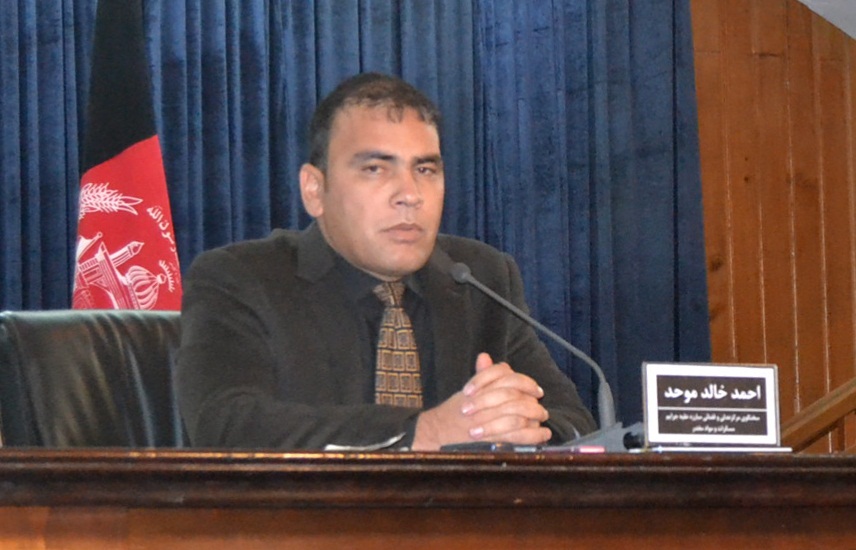590 drug traffickers sent behind bars
By Farhad Naibkhel-KABUL: Requesting international support, the Criminal Justice Task Force (CJTF) on Wednesday said that narcotics are a funding source for terrorists.
Spokesperson of the CJTF, Ahmad Khaled Moahed, said that link between terrorism and narcotics is evident.
He said that this international phenomenon, where annually world mafias earn $60-70 billion through narcotics, so only Afghanistan will fail to deal with this phenomenon. “The international community shall help Afghan security forces for further achievements.”
Providing details about the drug runners arrested in the recent months, he said that 590 drug smugglers were convicted to short and long term incarceration.
Moahed said that 598 smugglers were apprehended by the Counter Narcotics Police (CNP) during various crackdowns in different provinces in the past nine months and were handed over to CJTF for legal proceedings.
He said that the investigation was carried out by the CJTF, which after examining the evidences handed over the dossiers of the traffickers to the CJTF’s appellate court, where out of 598 smugglers 590 of them were jailed for three months to 20 years.
The spokesman said that 37 public servants, 14 women and two foreigners were also among the arrested smugglers. Providing details about the arrested government servants, he said that a teacher, police officer and even military general were detained and convicted.
He claimed that arrest of drug traffickers increased this year as compared to the previous year, adding that last year 490 smugglers were detained. Moahed termed better intelligence operation of CNP and “tireless efforts” main reasons for the achievements.
Over four ton heroin, 19kg morphine, 24 tons of opium, 158 tons of hashish, two tons of chemical precursor and over 13,000 liters alcoholic beverages were recovered and seized from the convicted smugglers at the time of arrest, he added. The CNP also recovered 136 rifles and ammunition from the drug runners.
The CJTF courts hold trials transparently by considering all legislative process, he noted.
It is pertinent to mention that around two months ago, the United Nations Office on Drugs and Crimes (UNODC) and Ministry of Counter Narcotics (MoCN) reported 48 percent decrease in opium production.
According to a survey report poppy cultivation has declined by 19 percent and opium production by 48 percent in 2015.
The survey had been conducted by Ministry of Counter Narcotics in joint venture with the UNODC, that estimated under poppy cultivation area 183,000 hectares in 2015. In 2014, poppy was cultivated on 224,000 hectares land. The cultivation has significantly decreased for the first time since 2009.
Minister of Counter Narcotics Salamat Azimi said that the survey in 2015 noted opium production 3,300 tons, where production in 2014 was 6,400 tons. Eradication of poppy fields increased 40 percent in 2015.
“Poppy cultivated on 3,760 hectares was eradicated in 2015. Poppy standing on 2,692 hectares was destroyed in 2014. Poppy cultivation was reported in twenty provinces,” she added.
Good coordination and cooperation among the Counter Narcotics Police (CNP) and other relevant organizations as well as well performance of the CNP were main factors behind the achievements, the minister claimed.
In October at the same press conference, Deputy Minister of Counter Narcotics at Ministry of Interior, General Baz Mohammad Ahmadi, said that in the past seven months CNP succeeded to arrest 1,682 drug traffickers and sized 45.6 tons of narcotics in 1,851 operations.
He said that 252 notorious drug traffickers, 65 medium category and 1,372 small drug smugglers are among the detained traffickers. “Twenty-seven government employees including eight policemen, nine soldiers and 10 female were among the apprehended drug traffickers,” he added.
The survey report came at a time when several neighboring and regional countries have expressed their concerns over smuggling of Afghan opium to the Eurasia and European states. The report will calm the concerns to some extent.
 Afghanistan Times
Afghanistan Times




